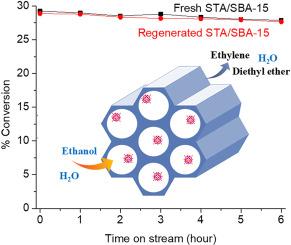Pivotal role of support architecture in encapsulating heteropolyacids: Enhancing water tolerance and suppressing leaching for aqueous ethanol dehydration
IF 5.8
2区 化学
Q2 CHEMISTRY, MULTIDISCIPLINARY
引用次数: 0
Abstract
Phosphotungstic acid (PTA) and silicotungstic acid (STA) encapsulated on a variety of porous materials (SBA-15, MCM-41, hierarchical zeolite ZSM-5 (h-ZSM-5) and hierarchical zeolite Beta (h-Beta)) were investigated for aqueous ethanol dehydration. Among the catalysts, the STA/SBA-15 consistently demonstrated the best catalytic activity, resulting in a high ethanol conversion and remarkable operating stability. On the other hand, the STA/h-Beta displayed considerably lower initial activity and greater deactivation. Thermal regeneration (300 °C) was quite effective in fully restoring the catalytic activity and selectivity that were acquired from the STA/SBA-15 (0.58 % decrease in ethanol conversion). However, the activity of STA/h-Beta was only partially recovered (15.09 % decrease in ethanol conversion). The leaching of active STA species during ethanol dehydration was the direct cause of the poor regeneration of the STA/h-Beta. The ICP analysis revealed a considerable drop in the tungsten content of the spent STA/h-Beta catalyst. This suggests that some STA was allowed to dissolve because it was not adequately contained in the hierarchical pore structure.

支撑结构在包封杂多酸中的关键作用:增强水耐受性和抑制水乙醇脱水的浸出
研究了磷钨酸(PTA)和硅钨酸(STA)在多种多孔材料(SBA-15、MCM-41、分级沸石ZSM-5 (h-ZSM-5)和分级沸石Beta (h-Beta))上的包封对乙醇水脱水的影响。在催化剂中,STA/SBA-15始终表现出最好的催化活性,具有较高的乙醇转化率和良好的操作稳定性。另一方面,STA/h-Beta表现出相当低的初始活性和更大的失活。热再生(300°C)可以完全恢复STA/SBA-15的催化活性和选择性(乙醇转化率降低0.58%)。然而,STA/h-Beta活性仅部分恢复(乙醇转化率下降15.09%)。乙醇脱水过程中活性STA的浸出是STA/h-Beta再生能力差的直接原因。ICP分析显示,废STA/h-Beta催化剂的钨含量显著下降。这表明一些STA被允许溶解,因为它没有充分包含在分层孔隙结构中。
本文章由计算机程序翻译,如有差异,请以英文原文为准。
求助全文
约1分钟内获得全文
求助全文
来源期刊

Sustainable Chemistry and Pharmacy
Environmental Science-Pollution
CiteScore
8.20
自引率
6.70%
发文量
274
审稿时长
37 days
期刊介绍:
Sustainable Chemistry and Pharmacy publishes research that is related to chemistry, pharmacy and sustainability science in a forward oriented manner. It provides a unique forum for the publication of innovative research on the intersection and overlap of chemistry and pharmacy on the one hand and sustainability on the other hand. This includes contributions related to increasing sustainability of chemistry and pharmaceutical science and industries itself as well as their products in relation to the contribution of these to sustainability itself. As an interdisciplinary and transdisciplinary journal it addresses all sustainability related issues along the life cycle of chemical and pharmaceutical products form resource related topics until the end of life of products. This includes not only natural science based approaches and issues but also from humanities, social science and economics as far as they are dealing with sustainability related to chemistry and pharmacy. Sustainable Chemistry and Pharmacy aims at bridging between disciplines as well as developing and developed countries.
 求助内容:
求助内容: 应助结果提醒方式:
应助结果提醒方式:


